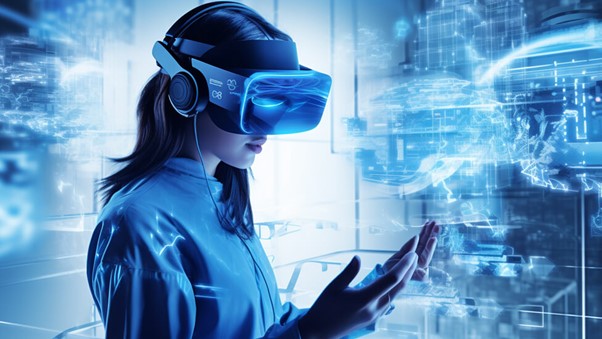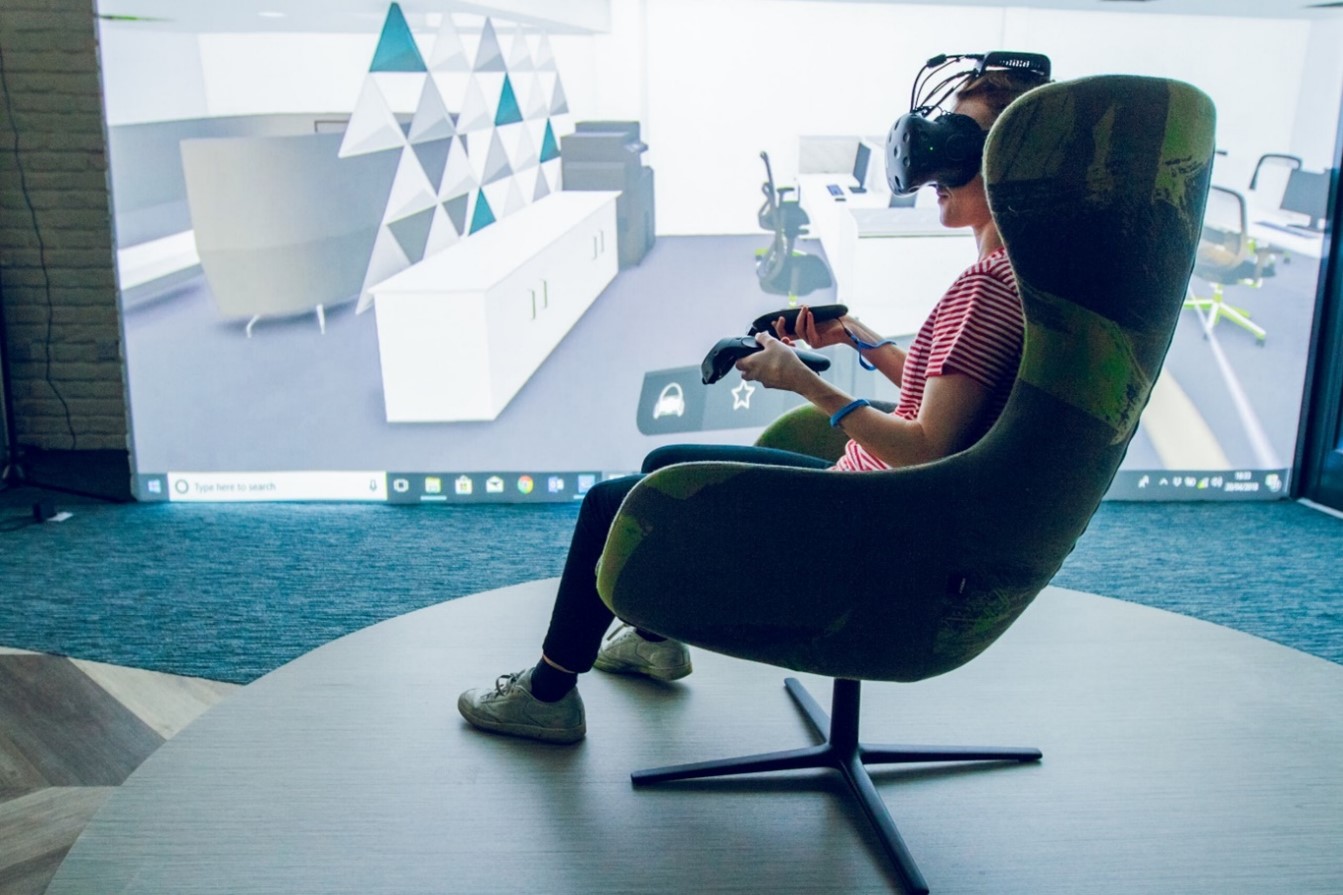In the world of commercial design, every detail matters—from the flow of foot traffic to the exact positioning of lighting fixtures. Traditionally, these details were ironed out during the design and fit-out phases, often involving physical models, multiple revisions, and, occasionally, costly mistakes. But what if you could step into your commercial space and experience it fully before construction even begins? With virtual reality (VR), this futuristic scenario is now a practical reality.
Virtual reality is revolutionizing how commercial spaces are designed and executed. By immersing stakeholders in a 3D environment that replicates the final space, VR offers unparalleled benefits in terms of time savings, accuracy, and sustainability. Let’s dive into the process and explore how designing commercial spaces in VR can transform your next project.

Understanding the basics – what are immersive technologies.
Immersive technology refers to advanced digital technologies that create a sense of being inside or deeply involved in a virtual or augmented environment. This technology blends the physical and digital worlds, making users feel as if they are part of the experience. The most common forms of immersive technology are Virtual Reality (VR), Augmented Reality (AR), and Mixed Reality (MR):
- Virtual Reality (VR): Completely transports users into a computer-generated environment, often (but not always) using a headset that covers their eyes and ears. In VR, users can look around and interact with the virtual world as if they are physically present in it.
- Augmented Reality (AR): Overlays digital information, such as images, sounds, or animations, onto the real world. This is usually done through a smartphone or tablet screen or AR glasses, enhancing the user’s view of their actual surroundings with additional content.
- Mixed Reality (MR): Combines elements of both VR and AR, allowing real and virtual worlds to interact in real time. Users can see and interact with both physical and digital objects, which can coexist and respond to each other.
Virtual reality in interior design is the process of creating wholly computer-generated environments that you can explore and interact with as if they were real. Imagine putting on a headset that covers your eyes and ears, instantly transporting you to a different world. This world could be anything—a city, a forest, or even outer space, though in our case usually a millimetre perfect digital replica of your unique work or hospitality space. We use this digital twin for space planning and as the basis of presenting a comparison between the existing and new concept designs.

Traditional 2D Design vs. 3D Virtual Reality (VR) Design
Traditional 2D Design:
- Flat and Fixed Perspective: 2D design is created on a flat surface, like a piece of paper or a computer screen. It has a fixed perspective, meaning you can only view the design from one angle. It can be difficult to interpret what elements are included within this type of design and what these may look like in reality.
- Limited Interaction: Interaction with 2D design is typically minimal. Users can click, scroll, or tap on elements, but they cannot change their viewpoint or interact with the design in a way that changes their spatial relationship to it.
- Simpler Tools and Techniques: Creating 2D designs often involves software like Adobe Photoshop, Illustrator, or other graphic design programs. The tools focus on working with shapes, colours, and text on a flat plane.
- Uses: 2D design is widely used in branding, advertising, print media, and digital platforms like websites and mobile apps. It’s effective for conveying clear, straightforward messages.
3D Virtual Reality (VR) Design:
- Immersive and Multi-Dimensional: VR design creates environments that users can enter and explore as if they were real. These environments are fully three-dimensional, allowing users to look around, move through, and interact with the space from any angle. This makes the experience highly immersive.
- Interactive Experience: In VR, users can interact with objects, change their perspective by moving their heads or bodies, and sometimes even manipulate the virtual environment with their hands using special controllers. This methodology in interior design allows actual finishes e.g. fabric to be used as simulated textures, actual paint colours used on walls and real furniture pieces exactly as you would buy shown within the space. This high level of interaction creates a more engaging experience and great clarity for the user.
- Complex Tools and Techniques: VR design requires specialised software that allows designers to build 3D models, animations, and environments. It also often involves knowledge of coding, 3D modelling, and user experience design tailored for VR.
- Uses: VR design is used in gaming, education, training simulations, architecture, real estate, and healthcare. It provides a way to experience scenarios and environments that might be difficult or impossible to access in real life.
The Process: Designing in Virtual Reality
- Conceptualisation: The journey begins with the basic design concept. Architects and designers create a 3D model of the commercial space using Building Information Modelling (BIM) software. This model includes all the structural elements, interiors, and even environmental factors like natural and artificial lighting influence.
- Virtual Walkthrough: Once the model is complete, it’s transferred into a VR environment. Here, stakeholders—whether they’re developers, agents, tenants, or interior designers—can don VR headsets and virtually walk through the space or join and view the experience via video conferencing (Teams/Zoom etc.). This immersive experience allows everyone to experience the layout, scale, and feel of the space as if they were physically present.
- Real-Time Adjustments: During the virtual walkthrough, reaction to feedback can be actioned in real-time. Maybe a conference room feels too cramped, or the reception area needs more natural light. Instead of waiting weeks for revisions, designers can make adjustments on the spot, and everyone can instantly see and sign-off the results.
- Finalising Design: After a couple of rounds of virtual walkthroughs and adjustments, the design is finalised. All decisions are captured in the BIM model, ensuring that every detail is accounted for before any physical work begins.
- Transition to Construction: The finalised VR model becomes the blueprint for construction and drawings are issued from the BIM software. With all the kinks ironed out virtually, the construction team can proceed with confidence, knowing that the design has been thoroughly vetted.
Time Savings: From Concept to Completion Faster
Designing in virtual reality significantly shortens the design timeline. Here’s how:
- Faster Decision-Making: Traditionally, design decisions are made through a series of meetings, emails, and revised drawings. With VR, these decisions can be made on the spot. Stakeholders don’t have to imagine how a change might look—they can see it instantly, allowing for faster consensus. Typically, this design approach will provide up to 50% in overall design time savings.
- Reduced Need for Physical Prototypes: In some cases, physical models or mood board mock-ups are created to help the client visualise a space. This process can be time-consuming and costly. VR eliminates the need for most physical prototypes, allowing for quicker iterations and refinements.
- Streamlined Communication: Miscommunications are a common cause of delays in commercial projects. VR provides a clear, shared vision of the space, ensuring that everyone is on the same page from the start and all stakeholders can be present either in the meeting or via Teams/Zoom type connections. This clarity reduces the back-and-forth that often stalls projects.
Accuracy: Getting It Right the First Time
One of the biggest advantages of VR design is its precision. When designing a commercial space, even small errors can lead to big problems. VR helps to mitigate these risks by ensuring accuracy at every stage:
- Exact Scale and Proportions: In a VR environment, you experience the space at its actual scale. This means you can accurately assess how large a room feels, how furniture fits, and whether there’s enough clearance for high-traffic areas. What looks good on paper might not work in reality—but in VR, you can catch these issues before they become expensive or timewasting mistakes. Project variation costs using this method are consistently under 2%, compared with an industry of 5-8%. This working methodology offers transparency and great financial certainty.
- Realistic Lighting and Acoustics: VR allows you to simulate natural and artificial lighting in the space, helping you make informed decisions about window placements, lighting fixtures, and colour schemes. You can also assess acoustics, ensuring that open-plan areas aren’t too noisy and that meeting rooms provide the necessary privacy.
- Detailed Simulation of Building Systems: BIM integrated with VR includes all mechanical, electrical, and plumbing (MEP) systems. You can see exactly where ducts, pipes, and wiring will go, ensuring that there are no clashes or unforeseen issues once construction begins. This level of detail helps avoid the need for expensive rework during the fit-out phase.
Sustainability: Building a Greener Future
Sustainability is more than just a buzzword—it’s a necessity. Designing commercial spaces in VR supports greener practices in several ways:
- Material Efficiency: By planning everything in a virtual environment, you can optimize the use of materials. VR allows you to experiment with different materials and configurations to minimize waste. When you know exactly what you need, there’s less over-ordering and fewer unused materials heading to the landfill.
- Energy Efficiency: VR simulations can include environmental factors such as sunlight, temperature, and airflow. By testing different design options, you can create a space that maximizes natural light and minimizes the need for artificial heating, cooling, and lighting. This results in lower energy consumption and a reduced carbon footprint.
- Reduced Travel Emissions: Stakeholders from different locations can meet virtually instead of flying or driving to project sites. This not only saves time but also reduces the carbon emissions associated with travel. For global projects, these savings can be substantial.
- Less Waste During Construction: Because VR allows you to finalize every detail before construction begins, there’s less need for on-site changes. Reducing these changes means less material waste and lower emissions from machinery and transportation.

The Future of Commercial Space Design
Designing commercial spaces in virtual reality isn’t just a trend—it’s the future. As VR technology continues to advance, its integration into the design process will only become more seamless and powerful. The ability to visualise, tweak, and perfect a space before it’s built offers undeniable advantages in terms of time savings, accuracy, and overall sustainability.
For developers, tenants, and designers, VR represents a much smarter, more efficient way to bring commercial spaces to life. By adopting this technology, you’re not just improving your bottom line—you’re also contributing to a more sustainable future.
So, as you plan your next commercial project, consider stepping into the virtual world first. It’s not just about seeing what your space will look like; it’s about building smarter, faster, and greener.
Please get in touch if you want to know more!


